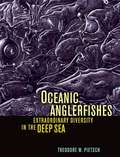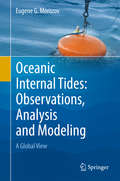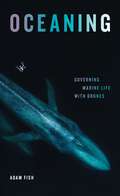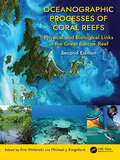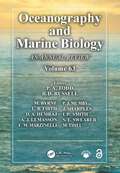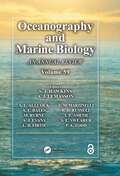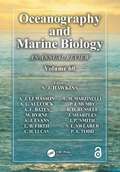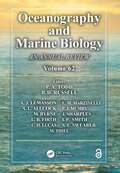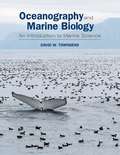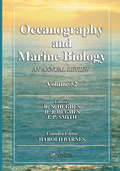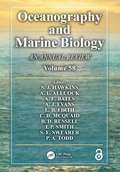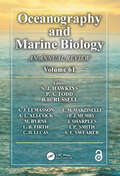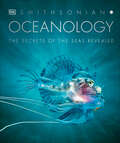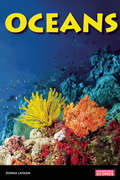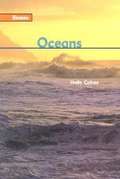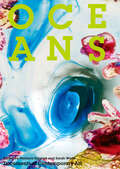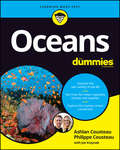- Table View
- List View
Oceanic
by Aimee NezhukumatathilWith inquisitive flair, Aimee Nezhukumatathil creates a thorough registry of the earth’s wonderful and terrible magic. In her fourth collection of poetry, she studies forms of love as diverse and abundant as the ocean itself. She brings to life a father penguin, a C-section scar, and the Niagara Falls with a powerful force of reverence for life and living things. With an encyclopedic range of subjects and unmatched sincerity, Oceanic speaks to each reader as a cooperative part of the earth, an extraordinary neighborhood to which we all belong.
Oceanic Anglerfishes: Extraordinary Diversity in the Deep Sea
by Theodore W. PietschNo environment on Earth imposes greater physical and biological constraints on life than the deep oceanic midwaters. Near-freezing temperatures, the absence of sunlight, enormous pressure, and a low food supply make habitation by any living thing almost inconceivable. Yet 160 species of anglerfishes are found there in surprising profusion. Monstrous in appearance, anglerfishes possess a host of unique and spectacular morphological, behavioral, and physiological innovations. In this fully illustrated book, the first to focus on these intriguing fish, Theodore W. Pietsch delivers a comprehensive summary of all that is known about anglerfishes--morphology, diversity, evolution, geographic distribution, bioluminescence, and reproduction.
Oceanic Internal Tides: Observations, Analysis and Modeling
by Eugene G. MorozovThis book presents a detailed study of the structure and variability of internal tides and their geographical distribution in the ocean. Based on experimental analysis of oceanic measurements combined with numerical modeling, it offers a comprehensive overview of the internal wave processes around the globe. In particular, it is based on moored buoys observations in many regions in all oceans (Atlantic, Pacific, Indian, Arctic, and Southern) that have been carried out by researchers from different countries for more than 40 years as part of various oceanographic programs, including WOCE and CLIVAR. However, a significant portion of the data was collected by the author, who is a field oceanographer. The data was processed and interpreted on the basis of the latest knowledge of internal wave motion. The properties of internal waves were analyzed in relation to the bottom topography and mean state of the ocean in specific regions. Internal waves play a major role in the formation of seawater stratification and are responsible for the main processes of ocean dynamics, such as energy transfer and mixing. One of the most significant ideas presented in this book is the generation of internal tides over submarine ridges. Energy fluxes from submarine ridges related to tidal internal waves greatly exceed the fluxes from continental slopes. Submarine ridges form an obstacle to the propagation of tidal currents, which can cause the creation of large amplitude internal tides. Energy fluxes from submarine ridges account for approximately one fourth of the total energy dissipation of the barotropic tides. Model simulations and moored measurements have been combined to generate a map of global distribution of internal tide amplitudes. This book is of interest to oceanographers, marine biologists, civil engineers, and scientists working in climate research, fluid mechanics, acoustics, and underwater navigation.
Oceaning: Governing Marine Life with Drones (Elements)
by Adam FishDrones are revolutionizing ocean conservation. By flying closer and seeing more, drones enhance intimate contact between ocean scientists and activists and marine life. In the process, new dependencies between nature, technology, and humans emerge, and a paradox becomes apparent: Can we have a wild ocean whose survival is reliant upon technology? In Oceaning, Adam Fish answers this question through eight stories of piloting drones to stop the killing of porpoises, sharks, and seabirds and to check the vitality of whales, seals, turtles, and coral reefs. Drone conservation is not the end of nature. Instead, drone conservation results in an ocean whose flourishing both depends upon and escapes the control of technologies. Faulty technology, oceanic and atmospheric turbulence, political corruption, and the inadequacies of basic science serve to foil governance over nature. Fish contends that what emerges is an ocean/culture—a flourishing ocean that is distinct from but exists alongside humanity.
Oceanographic Processes of Coral Reefs: Physical and Biological Links in the Great Barrier Reef
by Eric Wolanski Michael J. KingsfordIn the last two decades since publication of the first edition, substantial advancements have been made in the science, the need for transdisciplinary approaches to coral reef protection greater than ever before. This new edition, now in full color throughout with accompanying animations, goes beyond identifying foundational information and current problems to pinpoint science-based solutions for managers, stakeholders and policy makers. Coral reefs are connected by currents that carry plankton and the larvae of many reef-based organisms. Further, they supply food to reefs. Currents also bring pollutants from the land and, together with the atmosphere, affect the surrounding ocean. The chapters in this book provide a much-needed review of the biophysics of reefs with an emphasis on the Great Barrier Reef as an ecosystem. The focus is on interactions between currents, waves, sediment and the dynamics of coastal and reef-based ecosystems. The topographic complexity of reefs redirects mainstream currents, creates tidal eddies, mushroom jets, boundary layers, stagnation zones, and this turbulence is enhanced by the oceanographic chaos in the adjoining Coral Sea. This is the environment in which particles and organisms, of a range of sizes live, from tiny plankton to megafauna. This generates faunal connectivity at scales of meters to thousands of km within the Great Barrier Reef and with the adjoining ocean. Pollution from land-use is increasing and remedial measures are described both on land and on coral cays. The impact of climate change is quantified in case studies about mangroves and corals. Modelling this biophysical complexity is increasing in sophistication, and the authors suggest how the field can advance further.
Oceanography and Marine Biology: An Annual Review (Oceanography and Marine Biology - An Annual Review)
by L. B. Firth I. P. Smith S. E. Swearer P. A. Todd M. Thiel B. D. Russell A. J. Lemasson M. Byrne E. M. Marzinelli P. J. Mumby J. Sharples D. A. HemrajThe ever-increasing interest in work in oceanography and marine biology and its relevance to global environmental issues, especially global climate change and its impacts, creates a demand for authoritative refereed reviews summarising and synthesising the results of both historical and recent research. Oceanography and Marine Biology: An Annual Review continues to answer that need after six decades of publication.Volume 63 features a review of the factors affecting resilience and recovery of the coral reefs of the Andaman Sea, a systematic review of the 2014-2016 Northeast Pacific marine heatwave, an exploration of coexisting mangrove-coral habitats, a discussion of the problems and solutions in European cephalopod fisheries, a dive into the aquaculture of Rabbit fishes, an examination of how historical land reclamation and coastal urbanisation continue to shape Britain’s Ocean City and, finally, an examination of transferable stressors in small cetaceans.An international Editorial Board ensures global relevance and expert peer review, with editors from Australia, Denmark, Hong Kong, Ireland, Singapore and the UK. The series volumes find a place in the libraries of not only marine laboratories and oceanographic institutes but also universities worldwide. Three of the seven peer-reviewed contributions in Volume 63 are available to read Open Access via the webpage and on OAPEN.Supplementary material is provided online on the Support Materials tab for Reviews 1, 2, 3, 5, 6 and 7.Chapters 1, 2 and 7 of this volume are freely available as a downloadable Open Access PDF at http://www.taylorfrancis.com under a Creative Commons [Attribution-Non Commercial-No Derivatives (CC-BY-NC-ND)] 4.0 license.
Oceanography and Marine Biology: An Annual Review, Volume 55 (Oceanography and Marine Biology - An Annual Review)
by S. J. HawkinsOceanography and Marine Biology: An Annual Review remains one of the most cited sources in marine science and oceanography. The ever-increasing interest in work in oceanography and marine biology and its relevance to global environmental issues, especially global climate change and its impacts, creates a demand for authoritative refereed reviews summarizing and synthesizing the results of recent research. If you are interested in submitting a review for consideration for publication in OMBAR, please email the Editor in Chief, Stephen Hawkins, at S.J.Hawkins@soton.ac.uk. For nearly 60 years, OMBAR has been an essential reference for research workers and students in all fields of marine science. This volume considers such diverse topics as the Great Barrier Reef Expedition of 1928-29, Mediterranean marine caves, macromedusae in eastern boundary currents, marine biodiversity in Korea, and development of a geo-ecological carbonate reef system model to predict responses of reefs to climate change. Seven of the peer-reviewed contributions in Volume 59 are available to read Open Access on this webpage (1, 2, 3, 4, 5, 6 and 9). An international Editorial Board ensures global relevance and expert peer review, with editors from Australia, Canada, Hong Kong, Ireland, Singapore and the United Kingdom. The series volumes find a place in the libraries of not only marine laboratories and oceanographic institutes, but also universities worldwide.
Oceanography and Marine Biology: An Annual Review, Volume 60 (Oceanography and Marine Biology - An Annual Review #60)
by S. J. HawkinsOceanography and Marine Biology: An Annual Review remains one of the most cited sources in marine science and oceanography. The ever-increasing interest in work in oceanography and marine biology and its relevance to global environmental issues, especially global climate change and its impacts, creates a demand for authoritative refereed reviews summarizing and synthesizing the results of both historical and recent research. This Volume celebrates 60 years of OMBAR, over which time it has been an essential reference for research workers and students in all fields of marine science. The peer-reviewed contributions in Volume 60 are available to read Open Access via this webpage and on OAPEN. If you are interested in submitting a review for consideration for publication in OMBAR, please email the Editor-in-Chief, Stephen Hawkins (S.J.Hawkins@soton.ac.uk) for Volume 61. For Volume 62 onwards, please email the new co-Editors in Chief, Dr Peter Todd (dbspat@nus.edu.sg) and Dr Bayden Russell (brussell@hku.hk). Volume 60 features an editorial on the UN Decade of Ocean Science and goes on to consider such diverse topics as Cenozoic tropical marine biodiversity, blue carbon ecosystems in Sri Lanka, marine litter and microplastics in the Western Indian Ocean, and the ecology and conservation status of the family Syngnathidae in southern and western Africa. This volume also contains a retrospective Prologue on the evolution of OMBAR and pays tribute to one of its early Editors in Chief, Margaret Barnes, by providing an update on her review in OMBAR of the stalked barnacle Pollicipes. Supplementary online videos as well as additional Tables and Appendices are available on the Support Tab of the book's Routledge webpage. An international Editorial Board ensures global relevance and expert peer review, with editors from Australia, Canada, Hong Kong, Ireland, Singapore and the UK. The series volumes find a place in the libraries of not only marine laboratories and oceanographic institutes, but also universities worldwide.
Oceanography and Marine Biology: An Annual Review, Volume 62 (ISSN)
by L. B. Firth I. P. Smith A. L. Allcock S. E. Swearer P. A. Todd M. Thiel B. D. Russell A. J. Lemasson M. Byrne C. H. Lucas E. M. Marzinelli P. J. Mumby J. SharplesOceanography and Marine Biology: An Annual Review remains one of the most cited sources in marine science and oceanography. The ever-increasing interest in work in oceanography and marine biology and its relevance to global environmental issues, especially global climate change and its impacts, creates a demand for authoritative refereed reviews summarising and synthesising the results of both historical and recent research.If you are interested in submitting a review for consideration for publication in OMBAR, please email the new co-Editors in Chief, Dr Peter Todd (dbspat@nus.edu.sg) and Dr Bayden Russell (brussell@hku.hk).Supplementary material is provided online on the Support Materials tab, for Reviews 2, 5, 6, 7, 8, 9 and 10.Volume 62 features a review of the biology, ecology and conservation threats to the Iberian harbour porpoise; a look at the potential risk to Mediterranean cetaceans and sea turtles from floating marine macro litter; an overview of the recent history and physical environment of corals in the Andaman Sea; an exploration of the population biology of Snapper fish in South Australia; and a review of historical killings of small cetaceans in the Northeast Atlantic and Mediterranean Sea, among others.An international Editorial Board ensures global relevance and expert peer review, with editors from Australia, Canada, Hong Kong, Ireland, Singapore and the UK. The series volumes find a place in the libraries of not only marine laboratories and oceanographic institutes but also universities worldwide. Chapters 1, 2, 4, 6, 8 and 9 of this volume are freely available as a downloadable Open Access PDF at http://www.taylorfrancis.com under a Creative Commons [Attribution-Non Commercial-No Derivatives (CC-BY-NC-ND)] 4.0 license.
Oceanography and Marine Biology: An Introduction to Marine Science
by David W. TownsendOceanography and Marine Biology preserves the basic elements of the physical, chemical, and geological aspects of the marine sciences, and merges those fundamentals into a broader framework of marine biology and ecology. Existing textbooks on oceanography or marine biology address the companion field only cursorily: very few pages in oceanography texts are devoted to marine biology, and vice versa. This new book overcomes that imbalance, bringing these disparate marine science text formats closer together, giving them more equal weight, and introducing more effectively the physical sciences by showing students with everyday examples how such concepts form the foundation upon which to build a better understanding of the marine environment in a changing world. Lecturer supplements will also be available.
Oceanography and Marine Biology: An annual review. Volume 52 (Oceanography and Marine Biology - An Annual Review)
by I. P. Smith R. N. Hughes D. J. HughesEver-increasing interest in oceanography and marine biology and their relevance to global environmental issues creates a demand for authoritative reviews summarising the results of recent research. Oceanography and Marine Biology: An Annual Review has catered to this demand since its founding by the late Harold Barnes fifty years ago. Its objective
Oceanography and Marine Biology: An annual review. Volume 58 (Oceanography and Marine Biology - An Annual Review #58)
by S. J. Hawkins, A. L. Allcock, A. E. Bates, A. J. Evans, L. B. Firth, C. D. McQuaid, B. D. Russell, I. P. Smith, S. E. Swearer, and P. A. ToddOceanography and Marine Biology: An Annual Review remains one of the most cited sources in marine science and oceanography. The ever-increasing interest in work in oceanography and marine biology and its relevance to global environmental issues, especially global climate change and its impacts, creates a demand for authoritative refereed reviews summarizing and synthesizing the results of recent research. For more than 50 years, OMBAR has been an essential reference for research workers and students in all fields of marine science. If you are interested in submitting a review for consideration for publication in OMBAR, please email the Editor in Chief, Stephen Hawkins, at S.J.Hawkins@soton.ac.uk. This volume considers such diverse topics as optimal design for ecosystem-level ocean observatories, the oceanography and ecology of Ningaloo, human pressures and the emergence of novel marine ecosystems and priority species to support the functional integrity of coral reefs. Six of the nine peer-reviewed contributions in Volume 58 are available to read Open Access via the links on the Routledge.com webpage. An international Editorial Board ensures global relevance and expert peer review, with editors from Australia, Canada, Hong Kong, Ireland, Singapore, South Africa and the United Kingdom. The series volumes find a place in the libraries of not only marine laboratories and oceanographic institutes, but also universities worldwide. Chapters 1, 2, 3, 4, 5, 7, and 8 of this book are freely available as downloadable Open Access PDFs at http://www.taylorfrancis.com under a Creative Commons Attribution-Non Commercial-No Derivatives (CC-BY-NC-ND) 4.0 license.
Oceanography and Marine Biology: An annual review. Volume 61 (Oceanography and Marine Biology - An Annual Review #61)
by S. J. Hawkins L. B. Firth I. P. Smith A. L. Allcock S. E. Swearer P. A. Todd B. D. Russell A. J. Lemasson M. Byrne C. H. Lucas E. M. Marzinelli P. J. Mumby J. SharplesOceanography and Marine Biology: An Annual Review remains one of the most cited sources in marine science. The increasing interest in work in oceanography and marine biology and its relevance to global environmental issues, especially global climate change and its impacts, creates a demand for authoritative refereed reviews summarising and synthesising the results of both historical and recent research. For more than 50 years, OMBAR has been an essential reference for researchers, students and workers in all fields of marine science. An international Editorial Board ensures global relevance and expert peer review, with editors from Australia, Hong Kong, Ireland, Singapore, and the UK. The series of volumes can be found in the libraries of institutes and universities worldwide.Five of the seven peer-reviewed contributions in Volume 61 are available to read Open Access via this webpage and on OAPEN. Supplementary material is provided online on the Support Materials tab on the book’s www.routledge.com webpage for Reviews 1, 2, 4, 5 and 6.. Volume 61 features a review of 100 years of daily sea surface temperature from the Hopkins Marine Station in Pacific Grove, California; an exploration of the biology and life cycle of enigmatic crustacean y-larvae; a review of the science, policy and management of the Central and South Atlantic Deep Sea benthos; a review of the biodiversity of the Irish-Scottish continental margin; an investigation of how new molecular tools can be used for marine biodiversity and ecosystem assessments, and a look at the resilience of marine organisms to climate change. A final monograph considers enemy shells as refugia from grazing and competition pressure. If you are interested in submitting a review for consideration for publication in OMBAR, please email the new co-Editors in Chief, Dr Peter Todd (dbspat@nus.edu.sg) and Dr Bayden Russell (brussell@hku.hk). Guidelines for contributors to OMBAR, including information on illustration requirements, can be downloaded on the "Support Material" tab on the latest volume’s webpage.
Oceanology: The Secrets of the Sea Revealed (DK Secret World Encyclopedias)
by DKDive into this uniquely elegant visual exploration of the sea An informative and utterly beautiful introduction to marine life and the ocean environment, Oceanology brings the riches of the underwater world onto the printed page.Astounding photography reveals an abundance of life, from microscopic plankton to great whales, seaweed to starfish. Published in association with the Smithsonian Institution, the book explores every corner of the oceans, from coral reefs and mangrove swamps to deep ocean trenches. Along the way, and with the help of clear, simple illustrations, it explains how life has adapted to the marine environment, revealing for example how a stonefish delivers its lethal venom and how a sponge sustains itself by sifting food from passing currents. It also examines the physical forces and processes that shape the oceans, from global circulation systems and tides to undersea volcanoes and tsunamis.To most of us, the marine world is out of reach. But with the help of photography and the latest technology, Oceanology brings us up close to animals, plants, and other living things that inhabit a fantastic and almost incomprehensibly beautiful other dimension.
Oceans
by Donna LathamInvestigating the planet's biomes and examining the modern threats to each ecosystem, this interactive series challenges young readers to look at how their own actions affect the planet's health. With compare-and-contrast facts and vocabulary-building sidebars, each engaging guide reveals how environmental threats-both human and natural-affect plants and animals.Detailing the largest biome, this guide surveys the environmental threats to the earth's oceans. Teaching students about coral reefs-the rainforests of the ocean-this educational resource explores topics such as the connection between increasing levels of carbon dioxide in the atmosphere and the bleaching of the reefs. By comparing the size of an island of floating plastic and other trash in the middle of the Pacific Ocean to the state of Texas-and how that floating island impacts ocean life-the guide shows young environmentalists why consuming less plastic is important.
Oceans (Whitechapel: Documents of Contemporary Art)
by Sarah Wade Pandora SyperekOCEANS attends to the inextricable human and nonhuman agencies that affect and are affected by the sea and its running currents within contemporary art and visual culture.Oceans cover more than 70 percent of the Earth&’s surface, dividing and connecting humans, who carry saltwater in their blood, sweat and tears. They also represent a powerful nonhuman force, rising, flooding, heating and raging in unprecedented ways as the climate crisis unfolds. Artists have envisioned the sea as a sublime wilderness, home to mythical creatures and bizarre species, a source of life and death, a site of new beginnings and tragic endings, both wondrous and disastrous. From migration to melting ice caps, the sea is omnipresent in international news and politics, leaking into popular culture and proliferating in recent art and exhibitions. This anthology gathers artists and writers to address the ocean not only as a theme but as a major agent of artistic and curatorial methods.Artists surveyed includeBas Jan Ader, Eileen Agar, John Akomfrah, Heba Y. Amin, Shuvinai Ashoona, Betty Beaumont, Leopold & Rudolf Blaschka, Heidi Bucher, Marcus Coates, Tacita Dean, Chris Dobrowolski, Léuli Eshrāghi, Ellen Gallagher, Ayesha Hameed, Barbara Hepworth, Klara Hobza, Isuma, Brian Jungen, Tania Kovats, Sonia Levy, Armin Linke, Lani Maestro, Ana Mendieta, Kasia Molga, Eleanor Morgan, Wangechi Mutu, Saskia Olde Wolbers, Jean Painlevé and Geneviève Hamon, Allan Sekula, Shimabuku, Ahren Warner, Christine & Margaret Wertheim, Alberta WhittleWriters include Stacy Alaimo, Bergit Arends, Erika Balsom, Karen Barad, Rachel Carson, Mel Y. Chen, T.J. Demos, Marion Endt-Jones, Kodwo Eshun, Paul Gilroy, Stefano Harney, Epeli Hau&’ofa, Donna Haraway, Eva Hayward, Stefanie Hessler, Luce Irigaray, Zakiyyah Iman Jackson, Celina Jeffery, Melody Jue, Max Liboiron, Lana Lopesi, Chus Martínez, Jules Michelet, Fred Moten, Astrida Neimanis, Celeste Olalquiaga, Ralph Rugoff, John Ruskin, Marina Warner, Jan Verwoert
Oceans For Dummies
by Joseph Kraynak Philippe Cousteau Ashlan CousteauDive deep to explore the ocean From how most of our oxygen is created by phytoplankton, to how currents control our climate, to the marine food chain and the importance of coral, this is the holy grail of ocean books that’s easy for everyone to digest. It features fun facts about some of the most incredible, bizarre, and fascinating creatures in the ocean, from mantis shrimp that can strike things with the speed of a .22 caliber bullet to fish with clear heads that can see out of the top of their skulls. The ocean is full of wonders and there is still so much left to explore and understand. How our oceans work What creatures live in the ocean Find out how the ocean regulates our climate and weather patterns How growing pollution threatens our ocean and its inhabitants Oceans For Dummies is perfect for anyone with an interest in the ocean, including kids, adults, students, ocean lovers, surfers, fishermen, conservationists, sailors, and everyone in between.
Oceans and Human Health
by Robert E. Bowen Michael H. Depledge Lora E. Fleming Cinnamon P. CarlarneHuman health and well-being are tied to the vitality of the global ocean and coastal systems on which so many live and rely. We engage with these extraordinary environments to enhance both our health and our well-being. But, we need to recognize that introducing contaminants and otherwise altering these ocean systems can harm human health and well-being in significant and substantial ways.These are complex, challenging, and critically important themes. How the human relationship to the oceans evolves in coming decades may be one of the most important connections in understanding our personal and social well-being. Yet, our understanding of this relationship is far too limited.This remarkable volume brings experts from diverse disciplines and builds a workable understanding of breadth and depth of the processes - both social and environmental - that will help us to limit future costs and enhance the benefits of sustainable marine systems. In particular, the authors have developed a shared view that the global coastal environment is under threat through intensified natural resource utilization, as well as changes to global climate and other environmental systems. All these changes contribute individually, but more importantly cumulatively, to higher risks for public health and to the global burden of disease.This pioneering book will be of value to advanced undergraduate and postgraduate students taking courses in public health, environmental, economic, and policy fields. Additionally, the treatment of these complex systems is of essential value to the policy community responsible for these questions and to the broader audience for whom these issues are more directly connected to their own health and well-being."The seas across this planet and their effects on human society and its destiny are a fascinating subject for analysis and insights derived from intellectual inquiry. This diverse and complex subject necessarily requires a blending of knowledge from different disciplines, which the authors of this volume have achieved with remarkable success.""The following pages in this volume are written in a lucid and very readable style, and provide a wealth of knowledge and insightful analysis, which is a rare amalgam of multi-disciplinary perspectives and unique lines of intellectual inquiry. It is valuable to get a volume such as this, which appeals as much to a non-specialist reader as it does to those who are specialists in the diverse but interconnected subjects covered in this volume."(From the "Foreword" written by, R K Pachauri, Director General, TERI and Chairman, IPCC)
Oceans and Marine Resources in a Changing Climate
by Roger Griffis Jennifer HowardPrepared for the 2013 National Climate Assessment and a landmark study in terms of its breadth and depth of coverage, Oceans and Marine Resources in a Changing Climate is the result of a collaboration among numerous local, state, federal, and nongovernmental agencies to develop a comprehensive, state of the art look at the effects of climate change on the oceans and marine ecosystems under U. S. jurisdiction. This book provides an assessment of scientific knowledge of the current and projected impacts of climate change and ocean acidification on the physical, chemical, and biological components and human uses of marine ecosystems under U. S. jurisdiction. It also provides assessment of the international implications for the U. S. due to climate impacts on ocean ecosystems and of efforts to prepare for and adapt to climate and acidification impacts on ocean ecosystem, including · Climate-Driven Physical and Chemical Changes in Marine Ecosystems · Impacts of Climate Change on Marine Organisms · Impacts of Climate Change on Human Uses of the Ocean · International Implications of Climate Change · Ocean Management Challenges, Adaptation Approaches, and Opportunities in a Changing Climate · Sustaining the Assessment of Climate Impacts on Oceans and Marine Resources Rich in science and case studies, it examines the latest climate change impacts, scenarios, vulnerabilities, and adaptive capacity and offers decision makers and stakeholders a substantial basis from which to make informed choices that will affect the well-being of the region's inhabitants in the decades to come.
Oceans and Society: An Introduction to Marine Studies (Earthscan Oceans)
by Ana K. SpaldingThis unique textbook presents an introduction to the interdisciplinary field of marine studies, exploring the dynamic relationship between people and the marine environment. Emphasizing the human dimension of coastal and ocean issues, the book provides an innovative examination of the complex marine–human environment dynamics by drawing on social science and humanities approaches. Applying these interdisciplinary approaches, the textbook addresses key challenges facing the marine environment, including changing climate, fisheries, aquaculture, marine pollution, energy production, and management of areas beyond national jurisdiction. While leading with a human dimension approach to these challenges, the chapters are all firmly grounded in foundational knowledge about coastal and ocean environments and processes. The textbook also includes examples of professional or academic areas of specialization within marine studies such as social and environmental justice, governance, global perspectives, traditional ecological knowledge and management, entrepreneurship, community development, conservation, and the blue economy. Ultimately, the book provides the first cohesive resource on marine studies to educate students, train interdisciplinary marine leaders, inspire new knowledge about people and the sea, generate innovative solutions for sustainable oceans, and build capacity for a new generation of marine-focused professionals. Oceans and Society is essential reading for students on marine studies courses, as well as those studying marine governance, policy, conservation, and law more broadly. It will also be of great interest to students, researchers, and professionals interested in applying interdisciplinary approaches to environmental challenges.
Oceans in Danger (A True Book (Relaunch))
by Alicia GreenDiscover the rich biodiversity of Earth's biomes - and how they might be saved - with this STEAM-based subset of True Books.Did you know that Earth's five major oceans are all part of one giant global ocean? This biome is also home to the smallest animals on the planet - and the largest! Get ready to investigate Earth's mysterious ocean ecosystems, as well as the plants and animals that have adapted to survive in them. You'll also learn about the many threats facing this fascinating biome - and what each of us can do to help - all in the pages of Oceans in Danger.ABOUT THE SERIES:There are five major biomes on Earth: desert, forest, grassland, aquatic, and tundra. These rich, wild places are home to a wide variety of plants and animals - many of which are found nowhere else. Unfortunately, these ecosystems have been put at risk by human activities. This STEAM-based set of True Books introduces students to the incredible biodiversity of Earth's amazing biomes, as well as the threats they face in the era of climate change. Interesting information is presented in a fun, friendly way - and in the simplest terms possible - and will inspire kids to think about how they can help stop the destruction of Earth's wild spaces.
Oceans in Decline
by Sergio RossiWhat is happening in our oceans? By describing their main elements, this book shows how and why the oceans are being transformed, and suggests possible future scenarios to address this complex, yet often-asked, question. The ocean is being dramatically transformed, but the magnitude of this transformation remains unclear since the ocean is largely inaccessible and still unknown: there is more information about the outer universe than about the deepest parts of our oceans. The author, a marine biologist with extensive research experience, offers a holistic view of our oceans. Focusing on fishing, pollution and the effects of climate change, he identifies and describes the changes occurring in all marine ecosystems, and discusses the long-passed state of equilibrium.
Oceans of Kansas: A Natural History of the Western Interior Sea (Life of the Past)
by Michael J. Everhart“Excellent . . . Those who are interested in vertebrate paleontology or in the scientific history of the American midwest should really get a copy.” —PalArch’s Journal of Vertebrate PaleontologyRevised, updated, and expanded with the latest interpretations and fossil discoveries, the second edition of Oceans of Kansas adds new twists to the fascinating story of the vast inland sea that engulfed central North America during the Age of Dinosaurs. Giant sharks, marine reptiles called mosasaurs, pteranodons, and birds with teeth all flourished in and around these shallow waters. Their abundant and well-preserved remains were sources of great excitement in the scientific community when first discovered in the 1860s and continue to yield exciting discoveries 150 years later. Michael J. Everhart vividly captures the history of these startling finds over the decades and re-creates in unforgettable detail these animals from our distant past and the world in which they lived—above, within, and on the shores of America’s ancient inland sea.“Oceans of Kansas remains the best and only book of its type currently available. Everhart’s treatment of extinct marine reptiles synthesizes source materials far more readably than any other recent, nontechnical book-length study of the subject.” —Copeia“[The book] will be most useful to fossil collectors working in the local region and to historians of vertebrate paleontology . . . Recommended.” —Choice
Oceans under Glass: Tank Craft & the Sciences of the Sea (Oceans in Depth)
by Samantha MukaA welcome dive into the world of aquarium craft that offers much-needed knowledge about undersea environments. Atlantic coral is rapidly disappearing in the wild. To save the species, they will have to be reproduced quickly in captivity, and so for the last decade conservationists have been at work trying to preserve their lingering numbers and figure out how to rebuild once-thriving coral reefs from a few survivors. Captive environments, built in dedicated aquariums, offer some hope for these corals. This book examines these specialized tanks, charting the development of tank craft throughout the twentieth century to better understand how aquarium modeling has enhanced our knowledge of the marine environment. Aquariums are essential to the way we understand the ocean. Used to investigate an array of scientific questions, from animal behavior to cancer research and climate change, they are a crucial factor in the fight to mitigate the climate disaster already threatening our seas. To understand the historical development of this scientific tool and the groups that have contributed to our knowledge about the ocean, Samantha Muka takes up specialty systems—including photographic aquariums, kriesel tanks (for jellyfish), and hatching systems—to examine the creation of ocean simulations and their effect on our interactions with underwater life. Lively and engaging, Oceans under Glass offers a fresh history about how the aquarium has been used in modern marine biology and how integral it is to knowing the marine world.

